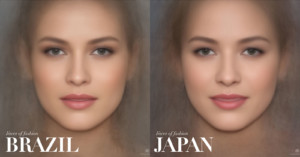
The Average Faces of Vogue Cover Models Around the World
This portrait is the average face of Vogue cover models over the past 25 years.

This portrait is the average face of Vogue cover models over the past 25 years.
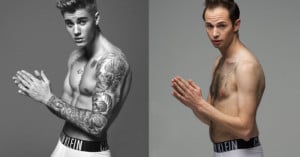
BuzzFeed's "Try Guys" are just average guys. But in this new video, they put themselves at the mercy of professional makeup artists, photographers, and (of course) some Photoshop retouching masters to see if they could recreate photos of buff, sexy male celebrities... and find out how those photos made them feel.
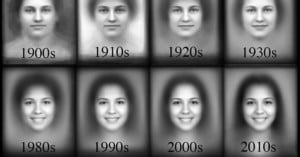
Smiling is a relatively recent phenomenon in the history of photography. If you take a look at photos from many decades ago, people commonly wore stoic expressions on their faces and portraits were a much more serious affair.
Researchers at UC Berkeley recently crunched through an enormous trove of high school yearbook photos to show how smiling and portraits have evolved over the past 100+ years.
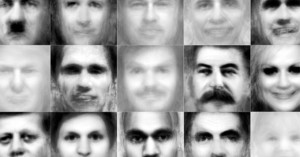
What do you get when you combine 50 portraits of the same famous face and averaged the result? Reddit user Dwainosaur dared to not only ask the question but to pursue it. He gathered up a large collection of photos and wrote a script for averaging the results. Subjects include Brad Pitt, Jack Black, Billy Murray, and Barack Obama. Infamous faces include Adolph Hitler and Joseph Stalin.
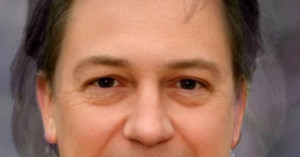
The image above may look strangely familiar to you. That’s because it’s a facial average of the leaders of the main political parties in this week’s general election in the UK. If you've been following UK politics, you have probably seen these people many times in the media, leading to an involuntary familiarity with them.
A facial average like the one above is created by digitally altering each person’s face to a matching position and expression, and then morphing them all together to create an average.
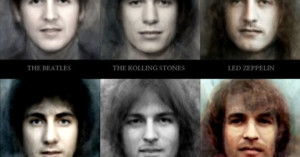
What do famous rock bands look like if you take portrait photos of each of their members and average them into a single face? The folks over at West Coast Shaving recently decided to find out.
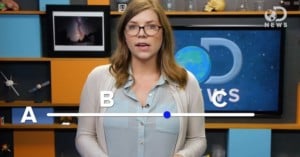
There are a lot of debates in the world of photography: Nikon Vs. Canon, DSLR Vs. Mirrorless and Full-Frame Vs. Everything Else just to name a few. But one of the battles that doesn't get as much air time probably has more impact on your images than any of the previous three. We're talking about The Rule of Thirds Vs. The Golden Ratio.
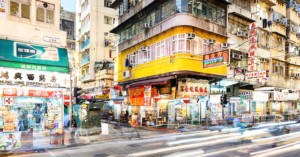
The idea of ‘average’ is strange, especially when it’s put into real-world situations and memories. The places most familiar to us change on a daily basis, even if it’s just the slightest bit, but when we look back, our brains piece together this conglomeration of what we’ve seen over the days, months and years to create a familiar, cohesive memory.
It was a similar line of thinking that inspired photographer Wolfgang Hildebrand to create his strangely chaotic compositions of city streets.
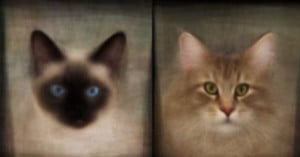
Researchers at UC Berkeley have created software that automatically averages hundreds or thousands of similar images to create the pinnacle of amalgamations.
Unveiled last month, AverageExplorer lets users see the average image that represents whatever collection of images they’re looking at. The idea is to break down the overwhelming amount of images given when searching through Google Images, Flickr or Bing and combining it into one visual summary of the result.
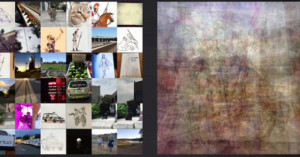
It turns out the average Instagram image looks a bit like a dirty piece of cloth, and we arrived at this Earth-shaking conclusion courtesy of a surprisingly addictive web app called Metagramme.

We've run across some neat web apps in the past -- be it the Face to GIF app that lets you create animated GIFs with ease using your computer's webcam, or something a bit more practical like UT's enlarging and denoising app.
The 'Average' web app definitely falls on the less-practical side of things. It allows you to easily combine any number of Flickr photos from a set or tag into a composite average of them all.
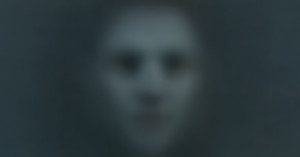
No, the creepy face above isn't a still frame of He-Who-Must-Not-Be-Named taken from one of the Harry Potter films. It's actually a composite portrait of countless faces found in the 2009 James Cameron science fiction film Avatar.
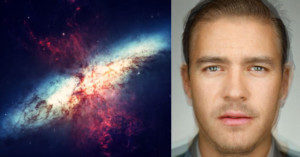
Between a recent post here on PetaPixel about the Beauty of Space Photography, and my own experiments on blending series of images using averaging techniques, I noticed some rather interesting alignments in technique.
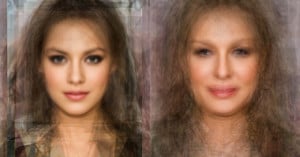
A while back, PetaPixel posted some features about image averaging and faces. Richard Prince created a composite portrait of the 57 faces of girlfriends on Seinfeld. This led to Pat David exploring the averaging of faces with Martin Schoeller’s portraits of celebrities.
I’ve long been interested in image averaging as well; as a measure of central tendency, I like that image averaging can highlight similarities and differences across an array of seemingly equivalent images.
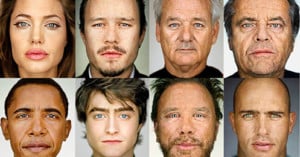
Yesterday, PetaPixel shared photographer Richard Prince's composite portrat created by blending together 57 faces of girlfriends seen on Seinfeld. I also enjoy playing with the idea of image averaging, and can't get enough of it. Late last year, I started experimenting with the idea of averaging faces by blending portraits.
I needed a set of faces that were all semi-similar enough to create good averages with. Well, if you haven't seen the work of photographer Martin Schoeller, you are missing out! He has a series of close-ups that are shot with very similar lighting styles and compositions of famous (and not-so-famous) people. It's simply mesmerizing to see. I grabbed the shots above to try face averaging out with.
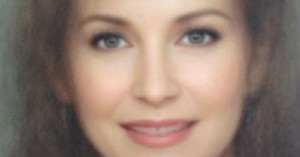
The woman in this portrait doesn't actually exist. The face is actually the average of 57 different women -- 57 girlfriends that appeared in episodes of the popular TV sitcom Seinfeld.
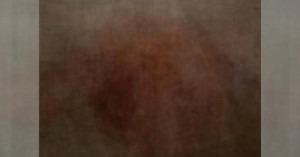
Photography enthusiast Sterling Parker created this abstract image by averaging all the photographs …
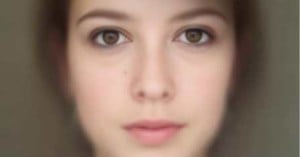
Inspired by Noah Kalina's viral everyday video a girl who goes by clickflashwhirr has been doing a similar self-portrait-a-day project. Designer Tiemen Rapati decided to make a composite image showing what the average of the self-portraits looks like. Taking 500 images from clickflashwhirr's Flickr set, Rapati wrote a script that counts the individual RGB values for each pixel, averaging them across the 500 portraits.
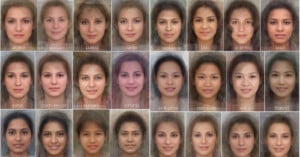
What you see here are portraits created by taking photographs of women in 40 different countries and averaging them with Face Research software. These are the most neutral faces for various nationalities.